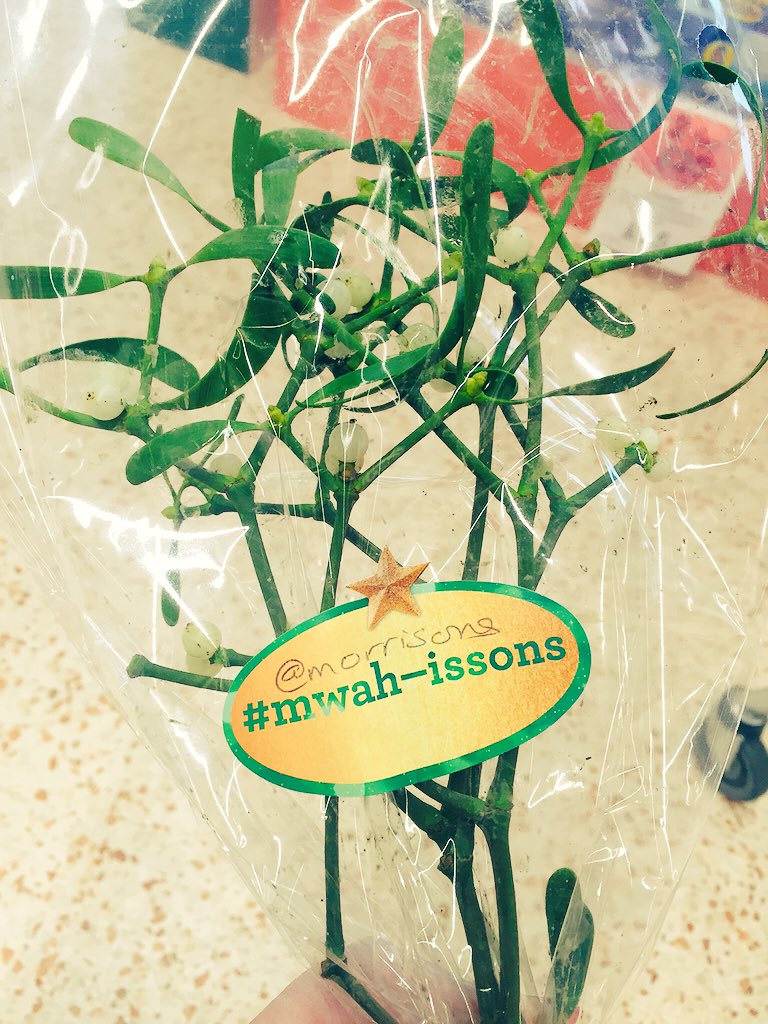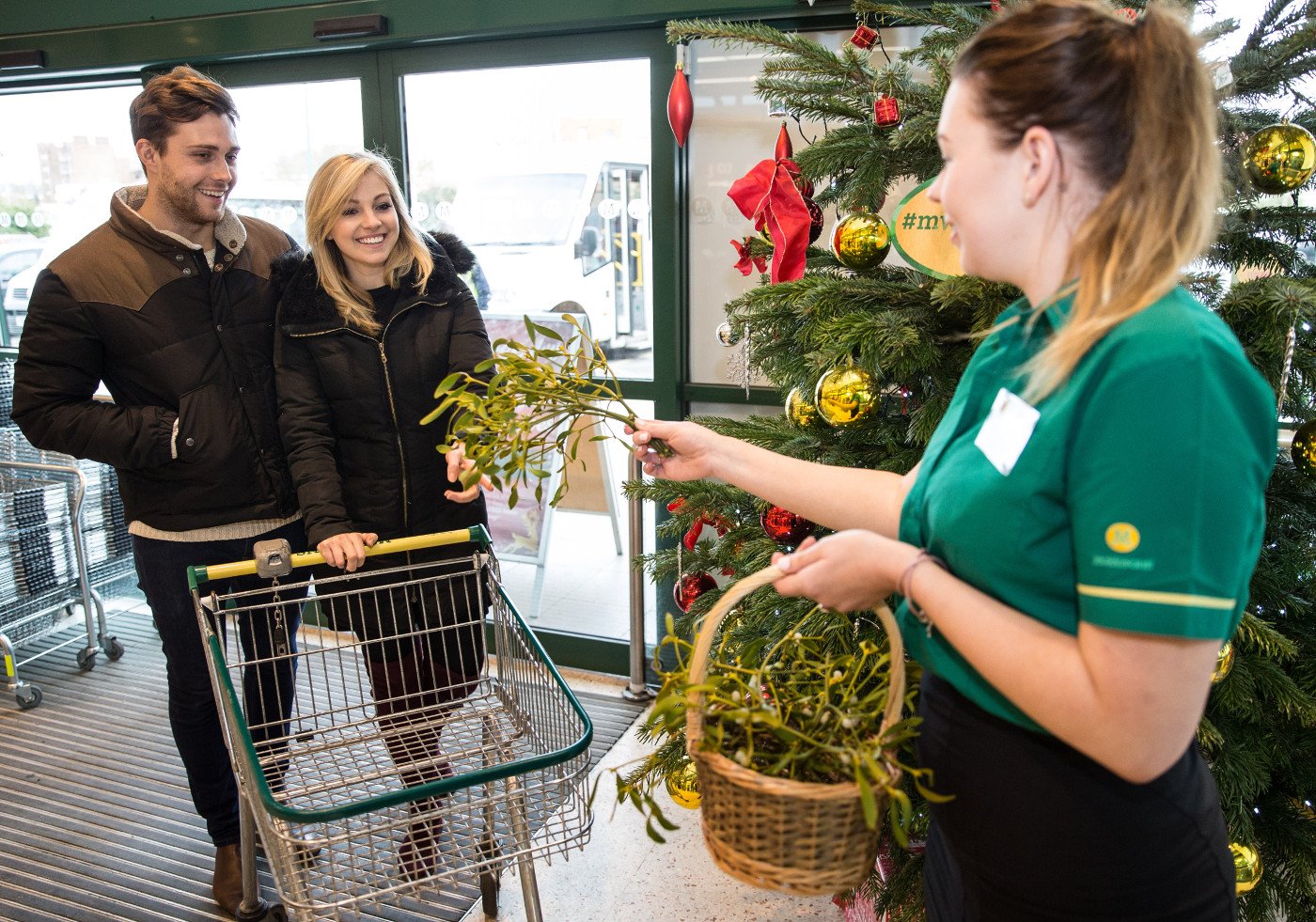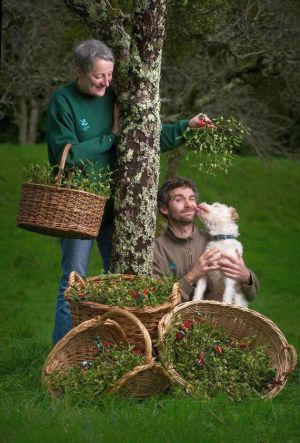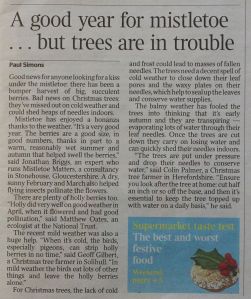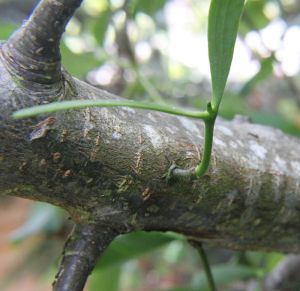
Mistletoe was due to be featured, live, on Sky News’ Sunrise show this morning. But David Cameron’s announcement about police and guns changed their schedules, and so the mistletoe got dropped. Which was a tad annoying, as Dave’s announcement wasn’t exactly exciting and could (surely) have waited until Monday (should I write to Dave to complain?). Whereas I had travelled over to Isleworth (in west London, where the Sky studios are) the night before, ready to take my place on the breakfast sofa brandishing mistletoe. On my very very best behaviour and remembering my lines. All arranged as a final flourish of Morrisons mistletoe promotion of last week.
I was all wound up, ready for action. And, having pulled a muscle in my back, which makes me yelp when sitting down or standing up, I’d even been practising a yelp-free stand-up routine (geddit?) in the mirror in my hotel room, just in case I had to sit or stand live on the telly.
And then I get the call, at 0810; it’s all off. What’s a mistletoe man to do in such circumstances? Dash straight home along the M4? Or make the most of it, regaining some mistletoe focus? I decided to do the latter, and with all the leaves off the host trees now, decide to make it a mistletoe-spotting road trip…

Mistletoe is, as I’m sure you know, a western species in Britain, so there isn’t much in the London area. But just upstream from Isleworth there is the biggest mistletoe population you’ll find in greater London, all centred in the Hampton Court and Bushy Park areas. I could have gone to admire that, but I’ve seen it all before. So I thought I’d explore a little further upstream, as there is, on the Thames corridor here, quite a lot more mistletoe in scattered colonies, and it would be interesting to do a drive-by of some of these. So I headed west, on the A4, past Heathrow (with a quick pilgrimage drive through Sipson, the village being bought by BAA), to pick up the Thames again, via more minor roads, at Windsor, where there is plenty of mistletoe locally.
 Mistletoe-spotting by car is hazardous, especially the unexpected sightings, and my first sightings, well before Windsor near Datchet were a bit of a shock. I didn’t know there were lots of mistletoe-bearing trees on the north bank of the Queen Mother Reservoir. But there are, right alongside the road and continuing into Datchet itself. A continuum of the mistletoe around Windsor, the next town along. The riverside and parkland trees in Windsor had, as expected, lots of mistletoe. (By the way I took no pictures today, it’s difficult enough spotting and logging mistletoe whilst driving, photos would be a hazard too many, so I’m illustrating this blog with maps).
Mistletoe-spotting by car is hazardous, especially the unexpected sightings, and my first sightings, well before Windsor near Datchet were a bit of a shock. I didn’t know there were lots of mistletoe-bearing trees on the north bank of the Queen Mother Reservoir. But there are, right alongside the road and continuing into Datchet itself. A continuum of the mistletoe around Windsor, the next town along. The riverside and parkland trees in Windsor had, as expected, lots of mistletoe. (By the way I took no pictures today, it’s difficult enough spotting and logging mistletoe whilst driving, photos would be a hazard too many, so I’m illustrating this blog with maps).
Heading west from Windsor towards Maidenhead I passed signs to Ascot and Bracknell, other places with mistletoe population outposts, but my road was due west, following (roughly) the Thames, so I ignored the temptation to stray. All these outpost populations have existed for ages – and seem natural. But they are quite likely to be the result of long-forgotten organised plantings, the main clue being that most are in historic formal parkland. And they seem to thrive best along the river corridor (or is that most of the parkland is in the river corridor?).
En route to Maidenhead I spot mistletoe in several places, including near Dorney (where the olympic rowing lakes are) and, on the edge of town, around the M4 link roundabout. Not huge populations like the Datchet/Windsor ones, but locally impressive.
From Maidenhead I head up-river to Cookham, and find some small colonies on the common near the Crown Inn, before crossing the river to Bourne End where there is more scattered here and there, again near the river but seeming to be petering out. Have I come to the end of the mistletoe?
 Onwards to Marlow, where I nearly decide to cut and run and return along the M40, but I go right round the A404 roundabout twice and head into town, to be instantly rewarded with mistletoe in the grounds of a school on the north side of the A4155. Plus, after driving a little randomly round the suburbs, quite a few sightings in gardens.
Onwards to Marlow, where I nearly decide to cut and run and return along the M40, but I go right round the A404 roundabout twice and head into town, to be instantly rewarded with mistletoe in the grounds of a school on the north side of the A4155. Plus, after driving a little randomly round the suburbs, quite a few sightings in gardens.
Thence to Henley, following the river quite closely from Mill End, where mistletoe is frequent from Henley Business School’s grounds through to Fawley Court (including a lime avenue with lots of mistletoe). Even beyond this area there were small growths in isolated trees, suggesting active spread…
On towards Wallingford, with surprise, surprise, lots of it in trees and parkland extending up the hill out of Henley, away from the river and a higher altitude, which should, on this side of the country, make mistletoe less likely. Not much in Wallingford itself though, but a few scattered sightings, including in Brightwell-cum-Sotwell, on the way to Didcot.
Little or no mistletoe by now, but this is compensated for by frequent sightings of Red Kites, often in groups, prospecting near the road for carrion, presumably roadkill. There are so many of these magnificent and distinctive birds on this section of the route that I find myself querying my bird recognition skills. But every time I check I confirm that yes that is a Red Kite, and so is that and that. Spotting Red Kites whilst driving is, by the way, a far more dangerous occupation than spotting mistletoe.
At Didcot there are still lots of Kites, some seeming quite at home in suburbia, a real change from their one-time status as endangered.
Then it’s on to Wantage and Faringdon, eventually getting back to the Thames at Lechlade. No obvious mistletoe in any of these places, and none beyond here either, in Fairford or Cirencester. Thames Head is near Cirencester, so this is the watershed between Thames and Severn. All downhill now to home territory in Stroud on the edge of the Severn Vale.
As I come off Rodborough Common, descending into Stroud on Walkley Hill, the mistletoe starts again, by Rodborough Church. This is proper mistletoe country now – and there’s loads of it round here.
Including a few large sprigs of it that are still on the back-seat of the car, having travelled from here to London and back, hoping for a brief moment on TV. I do hope those sprigs enjoyed the journey, especially the mistletoe-themed return road trip.
(Incidentally, that return journey was almost exactly the same mileage (105 ish)as the outward trip yesterday via Swindon and the M4. Today’s route had a lot of little wiggles, but overall was a more direct line, which compensated almost exactly. Took a lot longer though – much slower roads and frequent stops to make notes)
_________________________
Coming soon, from Mistletoe Diary:
Mistletoe Surveys
_________________________
More Mistletoe Matters – links to mistletoey things to read, buy or do
Grow-Your-Own Mistletoe – kits and gift cards from the English Mistletoe Shop
A Little Book About Mistletoe – printed and Kindle versions
Mistletoe Matters Consultancy – all about mistletoe in Britain
The Mistletoe Pages – even more about mistletoe
Mistletoe Surveys – seeking your input…
Mistletoe Matters on Facebook
Mistletoe Matters on Twitter







